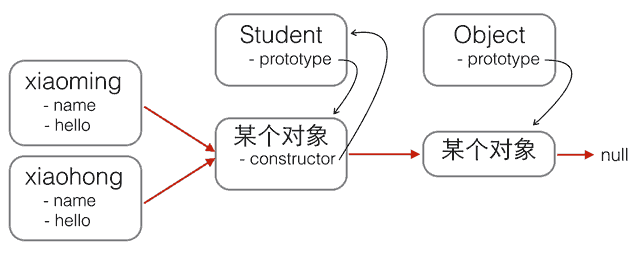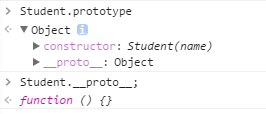04面向对象编程-01-创建对象 和 原型理解(prototype、__proto__)
1、JS中对象的”不同”:原型概念
从Java中我们可以很好地去理解 “类” 和 “实例” 两个概念,可是在JavaScript中,这个概念却不一样。
JavaScript不区分类和实例的概念,而是通过原型(prototype)来实现面向对象编程。
原型是指当我们想要创建一个具体对象时,并没有像Java中那样有类可以使用,但是却可以利用类似“继承”的方式,这里类似“父类”的对象,就是所谓的原型。(再简单点:原型也是一个对象,通过原型可以实现对象的属性继承)
比如:我们有一个Student对象,现在我们通过它作为原型,创建出xiaoming:
var Student = {
name: 'Robot',
height: 1.2,
run: function () {
console.log(this.name + ' is running...');
}
};
var xiaoming = {
name: '小明'
};
xiaoming.__proto__ = Student; //xiaoming的原型指向了对象Student13
1
var Student = { 2
name: 'Robot',3
height: 1.2,4
run: function () {5
console.log(this.name + ' is running...');6
}7
};8
9
var xiaoming = {10
name: '小明'11
};12
13
xiaoming.__proto__ = Student; //xiaoming的原型指向了对象Student这里的xiaoming有自己的name,但是没有定义run()方法,不过没关系,他是“继承“Student,所以只要Student有run()方法,xiaoming也就可以直接使用。
Object.create() 方法可以传入一个原型对象,并创建一个基于该原型的新对象,但这个新对象什么属性也没有。基于以上,我们也可以编写一个函数来创建xiaoming:
// 原型对象:
var Student = {
name: 'Robot',
height: 1.2,
run: function () {
console.log(this.name + ' is running...');
}
};
function createStudent(name) {
// 基于Student原型创建一个新对象:
var s = Object.create(Student);
// 初始化新对象:
s.name = name;
return s;
}
var xiaoming = createStudent('小明');
xiaoming.run(); // 小明 is running...
xiaoming.__proto__ === Student; // true20
1
// 原型对象:2
var Student = {3
name: 'Robot',4
height: 1.2,5
run: function () {6
console.log(this.name + ' is running...');7
}8
};9
10
function createStudent(name) {11
// 基于Student原型创建一个新对象:12
var s = Object.create(Student);13
// 初始化新对象:14
s.name = name;15
return s;16
}17
18
var xiaoming = createStudent('小明');19
xiaoming.run(); // 小明 is running...20
xiaoming.__proto__ === Student; // true2、创建对象 和 原型的理解
当我们使用 obj.xxx 访问一个对象的属性时,这个过程和Java中访问属性极为相似,都是顺着继承链不断往上搜寻。JavaScript引擎会先在当前对象查找,没找到就到其原型对象上找,一直如此直到追溯到 Object.prototype 对象,最后如果还没有找到,就只能返回 undefined。
比如我们有Array对象 var arr = [1, 2, 3]; 其原型链是 arr --> Array.prototype --> Object.prototype --> null,indexOf()等方法都是在Array.prototype中定义的,所以你可以在所有的Array对象上直接调用这些方法。
创建对象的方式:
- 使用 { ... } 创建
- 使用 new 构造函数
function Student(name) {
this.name = name;
this.hello = function () {
alert('Hello, ' + this.name + '!');
}
}
//这确实是一个普通函数,如果不写new的话;
//如果写了new,它就是一个构造函数,默认返回this,不需要在最后写return this;
var xiaoming = new Student('小明');
xiaoming.name; // '小明'
xiaoming.hello(); // Hello, 小明!
//这里的xiaoming原型就指向这个构造函数Student了14
1
function Student(name) {2
this.name = name;3
this.hello = function () {4
alert('Hello, ' + this.name + '!');5
}6
}7
//这确实是一个普通函数,如果不写new的话;8
//如果写了new,它就是一个构造函数,默认返回this,不需要在最后写return this;9
10
var xiaoming = new Student('小明');11
xiaoming.name; // '小明'12
xiaoming.hello(); // Hello, 小明!13
14
//这里的xiaoming原型就指向这个构造函数Student了new 的方式创建的对象,还从原型上获得了一个 constructor 属性,这个属性指向构造函数本身:
xiaoming.constructor === Student.prototype.constructor; // true
Student.prototype.constructor === Student; // true
Object.getPrototypeOf(xiaoming) === Student.prototype; // true
xiaoming instanceof Student; // true6
1
xiaoming.constructor === Student.prototype.constructor; // true2
Student.prototype.constructor === Student; // true3
4
Object.getPrototypeOf(xiaoming) === Student.prototype; // true5
6
xiaoming instanceof Student; // true好了好了,到这里就有点乱,什么constructor、prototype、__proto__ 等等,我们来理理概念先:
- constructor 属性,指向对象的构造函数,每个对象都有
- prototype 属性,是可以作为构造函数的函数对象,才具备的属性,比如这里的Student
- __proto__ 属性是任何对象(除了null)都具备的属性
- 上面两者的指向,都是其所属的原型对象。所以为什么构造函数有了__proto__还要有一个同样的prototype呢,当一个函数被用作构造函数来创建实例时,该函数的prototype属性值将被作为原型赋值给所有对象实例(即设置实例的__proto__属性)
所以上面我们提到的Student,我们输出它的prototype看看:

再看看小明的__proto__,很明显和Student.prototype是一样的,毕竟是赋值过来的:

可以看到,它们的原型对象有两个属性:constructor 和 __proto__ :
- 前者指向构造函数Student(),相当于是标记自己是和Student这个构造函数发生联系的;
- 后者指向是这个原型对象的原型对象,这里是Object
廖老师的原文中用了一张图来解释这些关系:

你可以把构造函数想象成女人A,某个实例对象是男人B(这个实例对象由其他构造函数产生),女人通过prototype属性指向男人,男人通过constructor属性指向女人,相互指向以后就相当于结婚仪式了,这下好了是夫妻了。
女人生下孩子时,就通过把prototype赋值给孩子的__proto__属性,相当于告诉他们让他们知道自己的父亲是谁。既然这些孩子知道父亲是谁了,正所谓 “龙生龙,凤生凤,老鼠的儿子会打洞”,这些孩子虽然本来没有学过什么技能,但是也可以通过他们的老爹继承,自然而然地会使用一些技能了。
所以,记住这句话,实际上,原型继承的本质是 “将构造函数的原型对象,指向由另一个构造函数创建的实例”
以上,我们可以再看看Student的 prototype 和 __proto__:

我们可以看到:
- prototype指向的原型对象,也就是xiaoming的老爹,是个没什么多余属性的几乎空白的一个对象,所以xiaoming没得到什么新能力
- 构造函数的原型对象(就是它爹)是一个空的函数 function( ) { }
看到这里,再结合之前的一个示例代码,我们稍微改动一下,当小明发现他的爹实际上是隔壁老王:
var laoWang = {
name: '隔壁老王',
height: 1.2,
run: function () {
console.log(this.name + ' is running...');
}
};
var xiaoming = {
name: '小明'
};
xiaoming.__proto__ = laoWang; //xiaoming的原型指向了对象Student //相当于告诉小明的爹是谁,比如小明的爹变成了老王
xiaoming.run(); // 小明 is running... //小明没定义run方法也会使用run()了15
1
var laoWang = {2
name: '隔壁老王',3
height: 1.2,4
run: function () {5
console.log(this.name + ' is running...');6
}7
};8
9
var xiaoming = {10
name: '小明'11
};12
13
xiaoming.__proto__ = laoWang; //xiaoming的原型指向了对象Student //相当于告诉小明的爹是谁,比如小明的爹变成了老王14
15
xiaoming.run(); // 小明 is running... //小明没定义run方法也会使用run()了需要注意的是,方法定义在构造函数中比如run定义在构造函数中,多个对象虽然都有run但是run方法是不同的,用 “===” 比较会得到 false;实际上他们可以共享同一个函数,把这个函数移动到原型对象里就好了,那么多个对象的方法相当于是继承的,而不是构造函数定义的,用 "===" 比较就会得到true。
function Student(name){
this.name = name;
this.run = function(){return this.name + "is running..."}
}
var xiaoming = new Student("xiaoming");
var xiaohong = new Student("xiaohong");
xiaoming.run === xiaohong.run;
//false
----------------------------------------------------------------------
function Student(name){
this.name = name;
}
Student.prototype.run = function(){return this.name + "is running..."}
xiaoming = new Student("xiaoming");
xiaohong = new Student("xiaohong");
xiaoming.run === xiaohong.run;
//true23
1
function Student(name){2
this.name = name;3
this.run = function(){return this.name + "is running..."}4
}5
6
var xiaoming = new Student("xiaoming");7
var xiaohong = new Student("xiaohong");8
9
xiaoming.run === xiaohong.run;10
//false11
12
----------------------------------------------------------------------13
function Student(name){14
this.name = name;15
}16
17
Student.prototype.run = function(){return this.name + "is running..."}18
19
xiaoming = new Student("xiaoming");20
xiaohong = new Student("xiaohong");21
22
xiaoming.run === xiaohong.run;23
//true3、其他的话
按照约定,构造函数的首字母要大写,普通函数的首字母才小写,用以区分。
调用构造函数的时候千万不要忘记写 new,否则函数作为普通函数被运行,this 会被绑定到全局对象window,无意间你就创建了一个全局变量。
我们可以写一个 createXXX() 函数,把 new 的操作封装进去:
function Student(props) {
this.name = props.name || '匿名'; // 默认值为'匿名'
this.grade = props.grade || 1; // 默认值为1
}
Student.prototype.hello = function () {
alert('Hello, ' + this.name + '!');
};
function createStudent(props) {
return new Student(props || {})
}12
1
function Student(props) {2
this.name = props.name || '匿名'; // 默认值为'匿名'3
this.grade = props.grade || 1; // 默认值为14
}5
6
Student.prototype.hello = function () {7
alert('Hello, ' + this.name + '!');8
};9
10
function createStudent(props) {11
return new Student(props || {})12
}这种方式不会遗漏new,参数也很灵活,可以不传,也可以传一个对象:
var xiaoming = createStudent({
name: '小明'
});
xiaoming.grade; // 1x
1
var xiaoming = createStudent({2
name: '小明'3
});4
5
xiaoming.grade; // 1如果创建的对象有很多属性,我们只需要传递需要的某些属性,剩下的属性可以用默认值。由于参数是一个Object,我们无需记忆参数的顺序。如果恰好从JSON拿到了一个对象,就可以直接创建出xiaoming。
除了廖老师的教程参考,其他参考链接:


 浙公网安备 33010602011771号
浙公网安备 33010602011771号